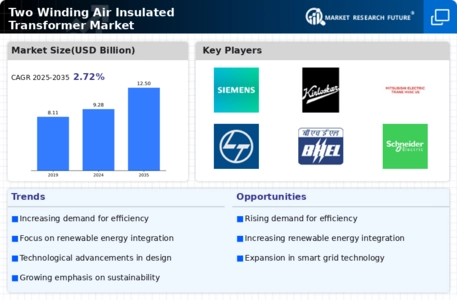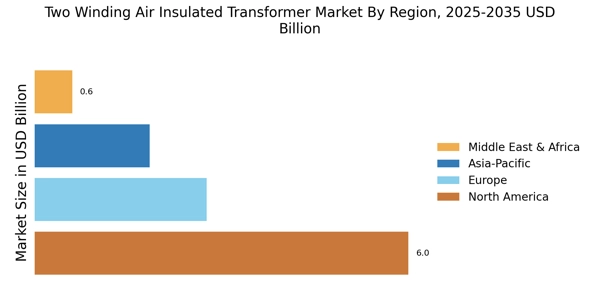Rising Demand for Renewable Energy
The increasing emphasis on renewable energy sources is driving the Two Winding Air Insulated Transformer Market. As countries strive to meet energy transition goals, the integration of wind and solar power into existing grids necessitates the use of efficient transformers. These transformers are essential for managing the variable output from renewable sources, ensuring stability and reliability in power distribution. The market for renewable energy is projected to grow significantly, with investments in solar and wind energy expected to reach trillions of dollars over the next decade. This trend indicates a robust demand for two winding air insulated transformers, which are crucial for connecting renewable energy systems to the grid.
Increased Focus on Energy Efficiency
The heightened focus on energy efficiency is a significant driver for the Two Winding Air Insulated Transformer Market. Regulatory bodies and organizations are implementing stringent energy efficiency standards, compelling manufacturers to develop transformers that minimize energy losses. Two winding air insulated transformers are recognized for their ability to operate with lower losses compared to traditional designs, making them a preferred choice for energy-conscious consumers. The global push towards reducing carbon footprints and enhancing energy efficiency is expected to propel the demand for these transformers. Market analysts predict that the energy efficiency sector will continue to expand, further solidifying the role of two winding air insulated transformers in achieving sustainability goals.
Infrastructure Development Initiatives
Infrastructure development initiatives are a key driver for the Two Winding Air Insulated Transformer Market. Governments and private sectors are investing heavily in modernizing electrical grids and expanding transmission networks to accommodate growing energy demands. This expansion often involves the installation of new substations and transformers, including two winding air insulated transformers, which are favored for their efficiency and reliability. According to recent reports, the global investment in infrastructure is expected to exceed several trillion dollars by 2030, creating a substantial market opportunity for transformer manufacturers. The need for enhanced grid resilience and capacity further underscores the importance of these transformers in contemporary infrastructure projects.
Growing Industrialization and Urbanization
The ongoing trends of industrialization and urbanization are driving the Two Winding Air Insulated Transformer Market. As urban areas expand and industries grow, the demand for reliable and efficient power distribution systems increases. Two winding air insulated transformers play a crucial role in ensuring that electrical supply meets the rising consumption levels in urban centers and industrial hubs. The urban population is projected to reach billions by 2050, necessitating substantial investments in power infrastructure. This demographic shift indicates a robust market potential for transformers that can support the increasing energy needs of both residential and commercial sectors.
Technological Innovations in Transformer Design
Technological innovations in transformer design are significantly influencing the Two Winding Air Insulated Transformer Market. Advances in materials and engineering techniques have led to the development of more efficient and compact transformers, which are increasingly preferred in various applications. These innovations not only enhance performance but also reduce operational costs, making them attractive to utility companies and industrial users. The market is witnessing a shift towards smart transformers that incorporate digital technologies for monitoring and control, aligning with the broader trend of digitalization in the energy sector. As these technologies continue to evolve, they are likely to drive further growth in the transformer market.


















Leave a Comment